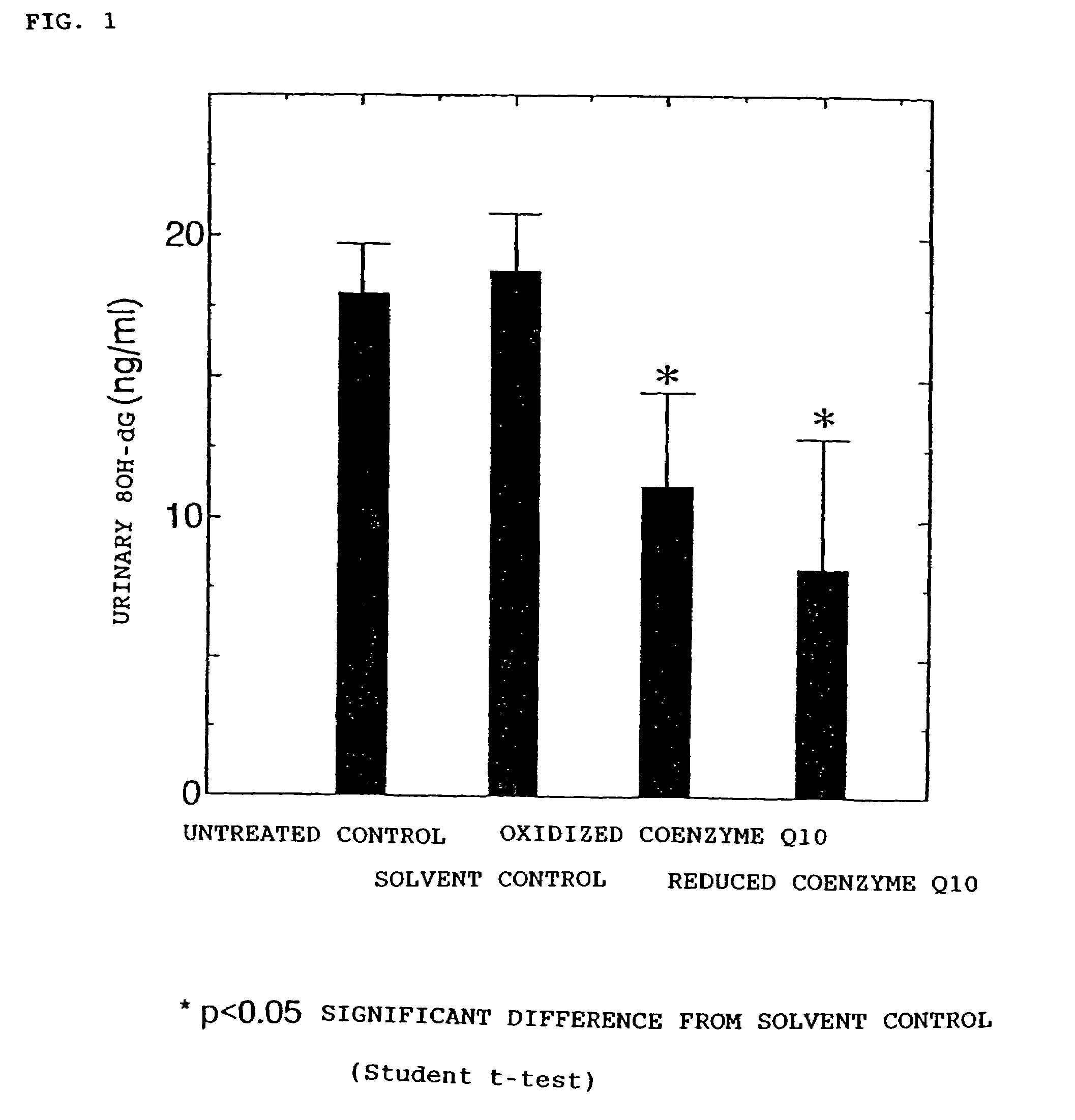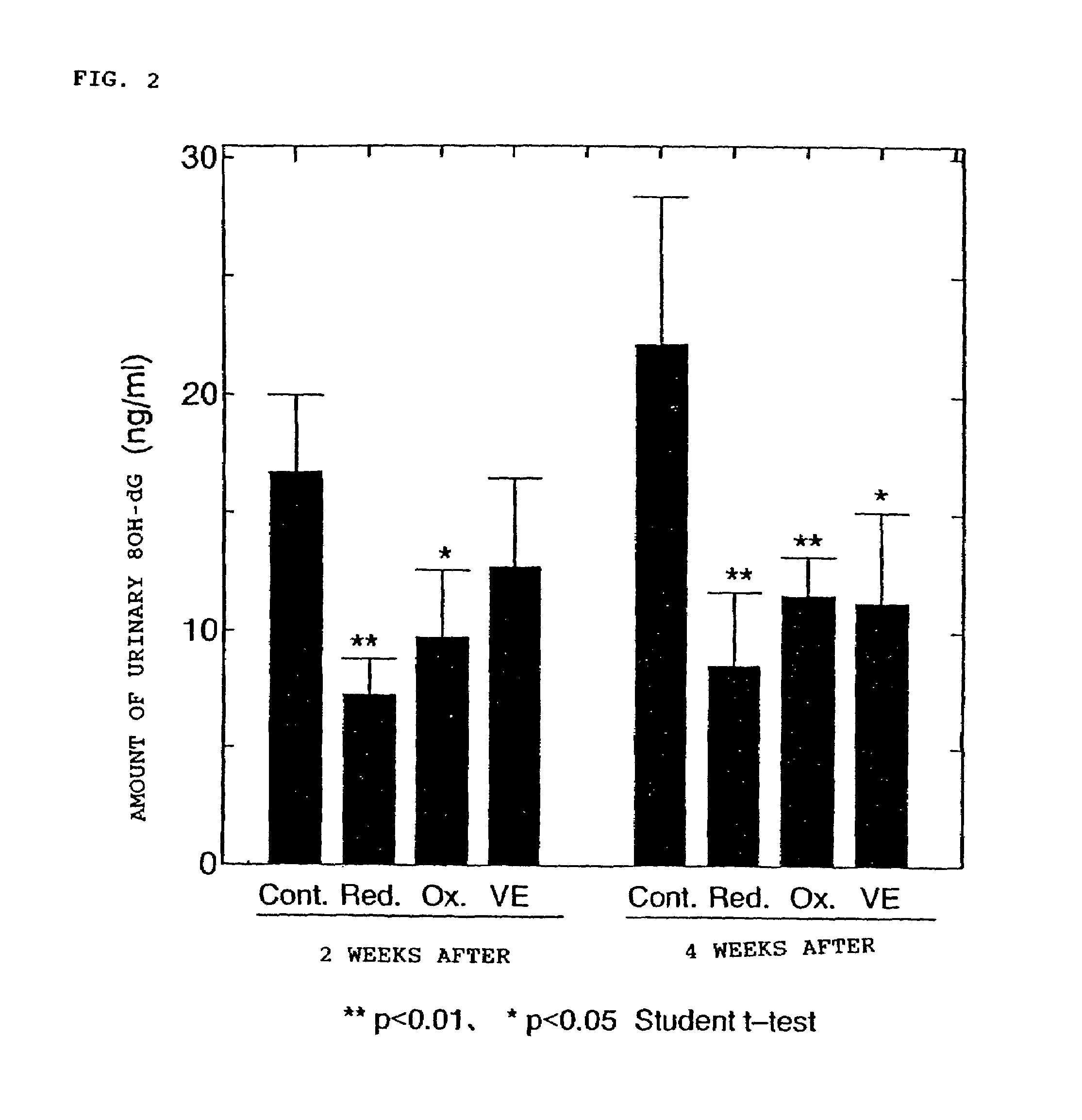Compositions for lessening oxidative stress
- Summary
- Abstract
- Description
- Claims
- Application Information
AI Technical Summary
Benefits of technology
Problems solved by technology
Method used
Image
Examples
example 1
Oxidative Stress Lessening Effect on Normal Rat
[0025]A soybean oil solution of oxidized coenzyme Q10 or reduced coenzyme Q10 (containing about 2% of oxidized coenzyme Q10) was orally administered to SD rats (6-week old, male) in a dose of 100 mg / kg / day for 4 weeks. 4 weeks after, urine was collected, and the amount of urinary 80H-dG was determined by an ELISA kit (Japan Institute for the Control of Aging). The results are shown in FIG. 1. In the oxidized coenzyme Q10 administration group, the amount of urinary 80H-dG was significantly decreased to about 60% of that of the solvent control group (urinary 80H-dG was assumed as 100%). In the reduced coenzyme Q10 administration group, the amount of urinary 80H-dG was significantly decreased to about 40% of that of the solvent control group.
example 2
Oxidative Stress Lessening Effect on Spontaneously Diabetic Rat
[0026]The oxidative stress lessening effect of each of reduced and oxidized coenzyme Q10 in vivo was evaluated by using GK rats with spontaneous diabetes which induced spleen tissue denaturation due to oxidative stress in vivo. A feed (CE-2, produced by CLEA JAPAN, INC.) containing 0.1% by weight of reduced coenzyme Q10 (containing about 2% by weight of oxidized coenzyme Q10) or oxidized coenzyme Q10 was freely given to GK rats (5-week old, male, n=4 in each group). In a control group, the feeds not containing coenzyme Q10 was freely given to the rats. 2 weeks and 4 weeks after, urine was collected, and the amount of urinary 80H-dG was determined by the same method as in Example 1. The results are shown in FIG. 2. In the reduced coenzyme Q10 administration group, the amount of urinary 80H-dG measured 2 weeks after the administration was significantly decreased to about 40% of that of the control group (urinary 80H-dG was...
reference example 1
Oxidative Stress Lessening Effect of Vitamin E on Spontaneously Diabetic Rat
[0027]The oxidative stress lessening effect of a typical antioxidant, vitamin E, was evaluated by using GK rats in the same test system as in Example 2. Like coenzyme Q10, vitamin E was mixed with a feed at a ratio of 0.1% by weight, and the resulting foodstuff was freely given to the GK rats. 2 weeks and 4 weeks after the feeding, the amount of urinary 80H-dG was determined. The results are shown in FIG. 2. In the vitamin administration group, the amount of urinary 80H-dG measured 2 weeks after the administration was decreased to about 80% of that of the control group, and only a downward tendency was exhibited. The amount of urinary 80H-dG measured 4 weeks after the administration was significantly decreased to 51%. In comparison to the coenzyme Q10 administration group of Example 2, 2 weeks after, the decreasing effect in Reference Example 1 was lower the effects of both the reduced form and the oxidized ...
PUM
| Property | Measurement | Unit |
|---|---|---|
| Percent by mass | aaaaa | aaaaa |
| Percent by mass | aaaaa | aaaaa |
| Mass flow rate | aaaaa | aaaaa |
Abstract
Description
Claims
Application Information
 Login to View More
Login to View More - R&D
- Intellectual Property
- Life Sciences
- Materials
- Tech Scout
- Unparalleled Data Quality
- Higher Quality Content
- 60% Fewer Hallucinations
Browse by: Latest US Patents, China's latest patents, Technical Efficacy Thesaurus, Application Domain, Technology Topic, Popular Technical Reports.
© 2025 PatSnap. All rights reserved.Legal|Privacy policy|Modern Slavery Act Transparency Statement|Sitemap|About US| Contact US: help@patsnap.com



